Biohabitats Projects, Places, and People
By Amy Nelson
Projects
Big Year for Baltimore
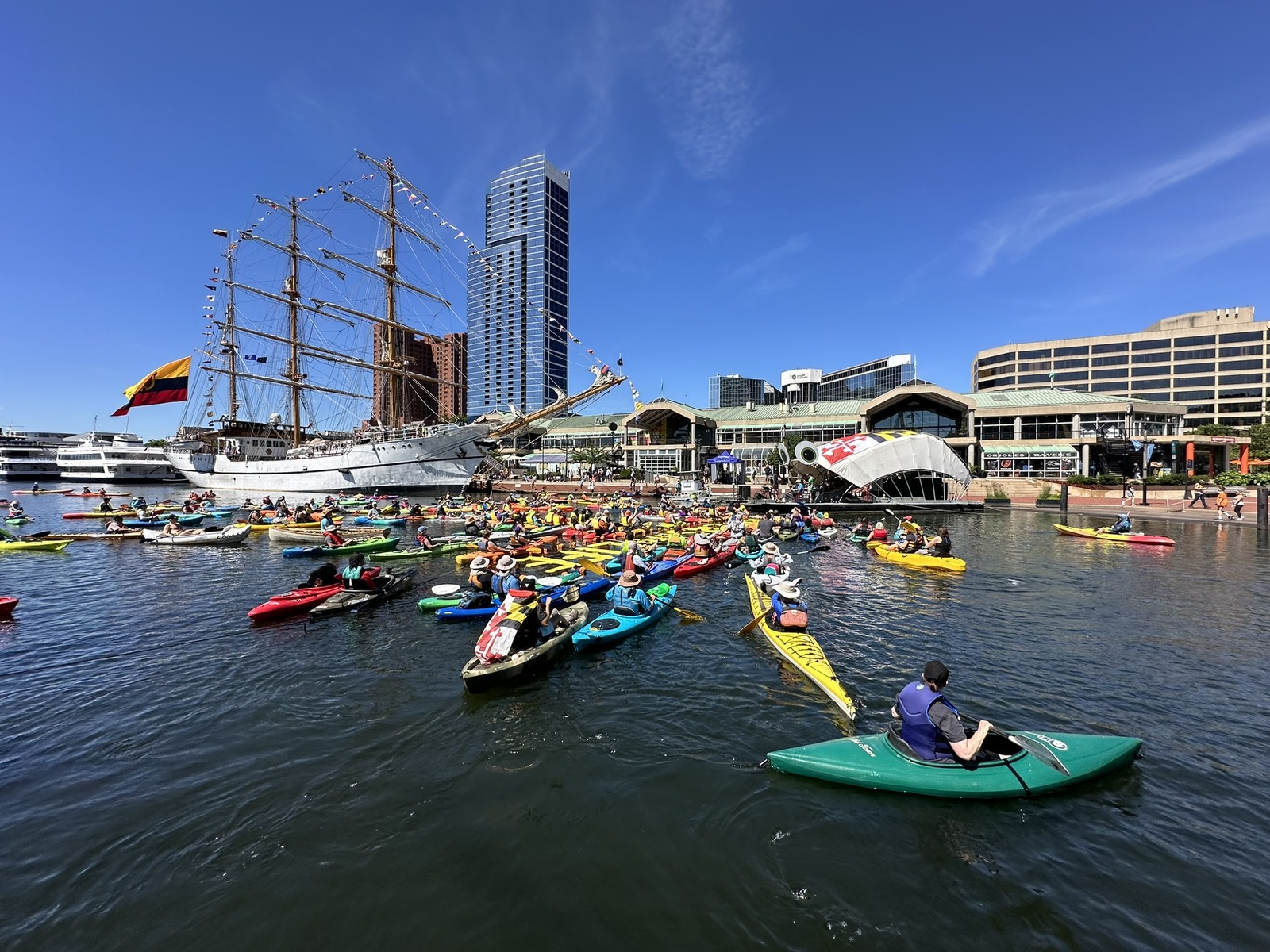
The Waterfront Partnership of Baltimore (WPB) works to revitalize Baltimore City’s blue and green spaces, promote sustainable practices, and foster community engagement to create a more accessible, exciting waterfront district. Fourteen years ago, when WPB launched the Healthy Harbor Initiative and announced the seemingly audacious goal of a swimmable, fishable Inner Harbor, Biohabitats was right there with them.
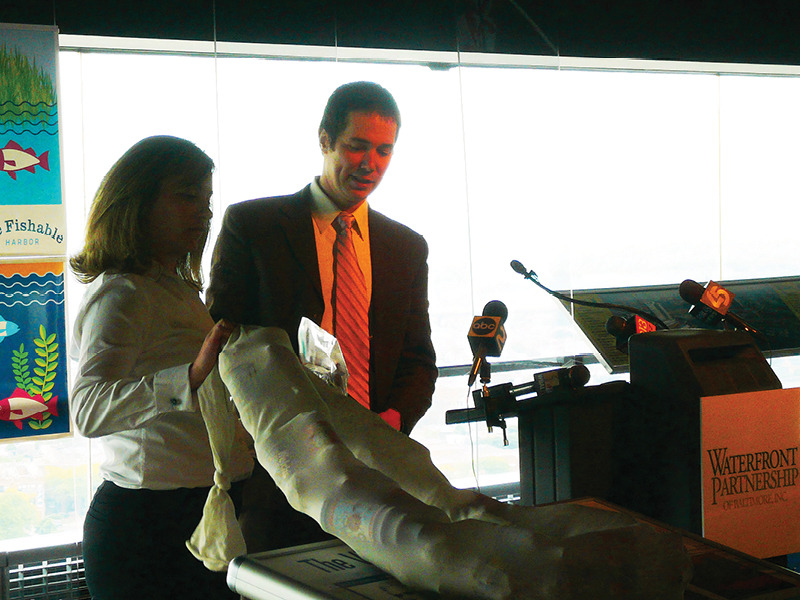
In 2024, the efforts of so many people, organizations, and agencies have brought Baltimore closer to that goal than ever before, and the community celebrated by launching our kayaks and even jumping right in!
Among the many efforts that are part of WPB’s Healthy Harbor Initiative is the Baltimore Blueway, a network of water trails and public access points for kayaks, canoes, paddle boards, and other non-motorized craft that will connect cultural, historic, and natural sites throughout the city’s iconic waterfront. The Baltimore Blueway is an exciting new experience for residents and visitors alike, and the New York Times took notice in their article 52 Places to Go in 2024 – Charm City and the Blueway made number 14!
In June, we had a memorable time rocking out and supporting a clean and resilient harbor at WPB’s 7th annual Baltimore Floatilla. This year’s event brought 350 paddlers and raised money for the Healthy Harbor Initiative and the Maryland Tough Baltimore Strong relief fund for those impacted by the collapse of the Key Bridge. The Biohabitats crew attended aboard S.S. Crabby Abbey and had the honor of setting up the floating “Rivers are Life” sign in the Inner Harbor.
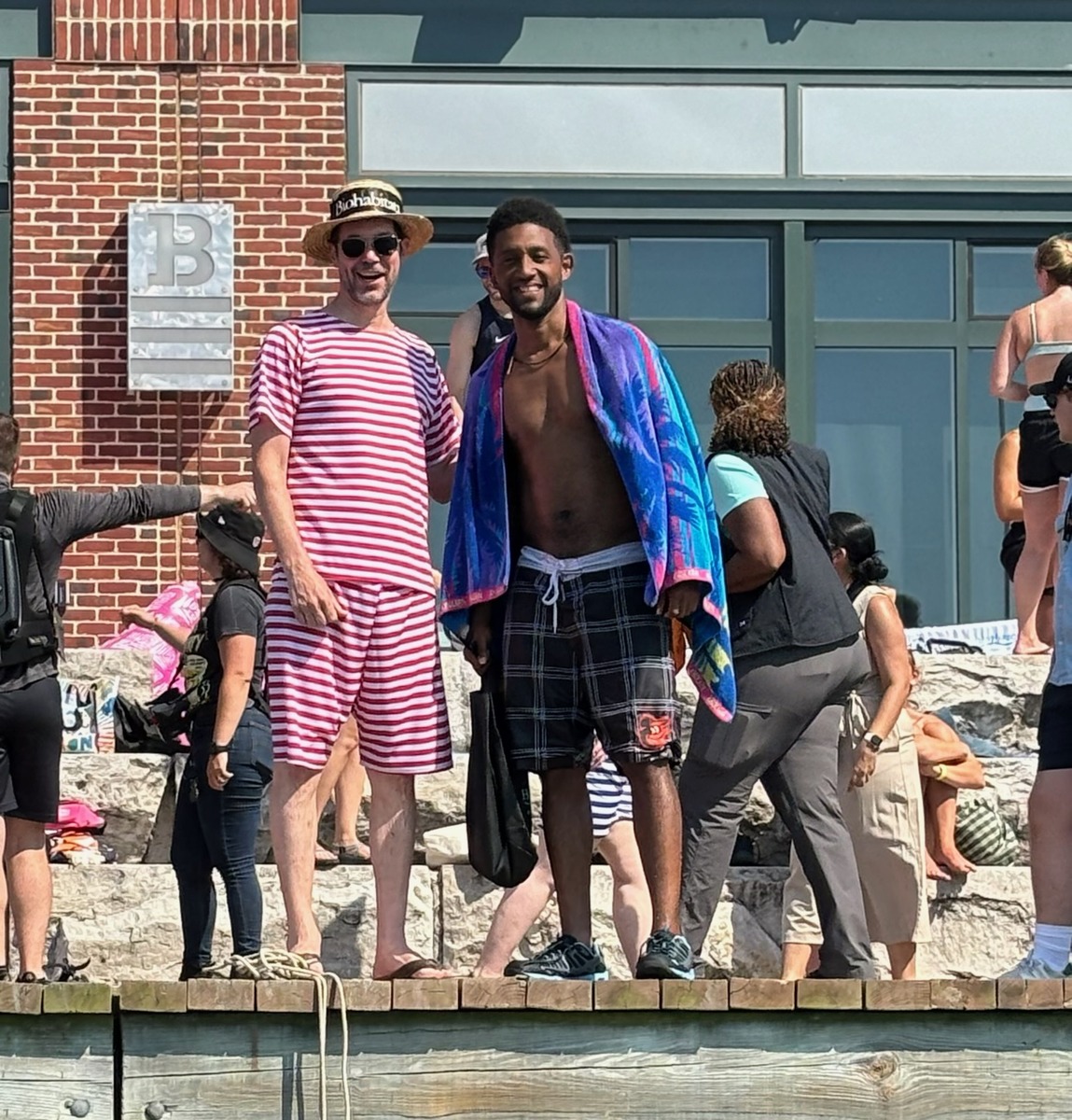
Two Biohabitats team members were also fortunate to be among the 150 participants who literally immersed themselves in the realization of WPB’s vision at the 2024 Harbor Splash. Biohabitats’ Learning & Innovation Leader Chris Streb and Water Resources Engineer Sarah Emrich took the plunge alongside Baltimore Mayor Brandon Scott, professional Oriole’s hype man Mr. Splash, Salvage Arc’s Evan Woodard, WPB’s Adam Lindquist, and other notable locals. (Check out the Rhizome blog to hear from Biohabitats’ team members about their Harbor Splash experiences. You can join us next time at Harbor Splash 2025!)
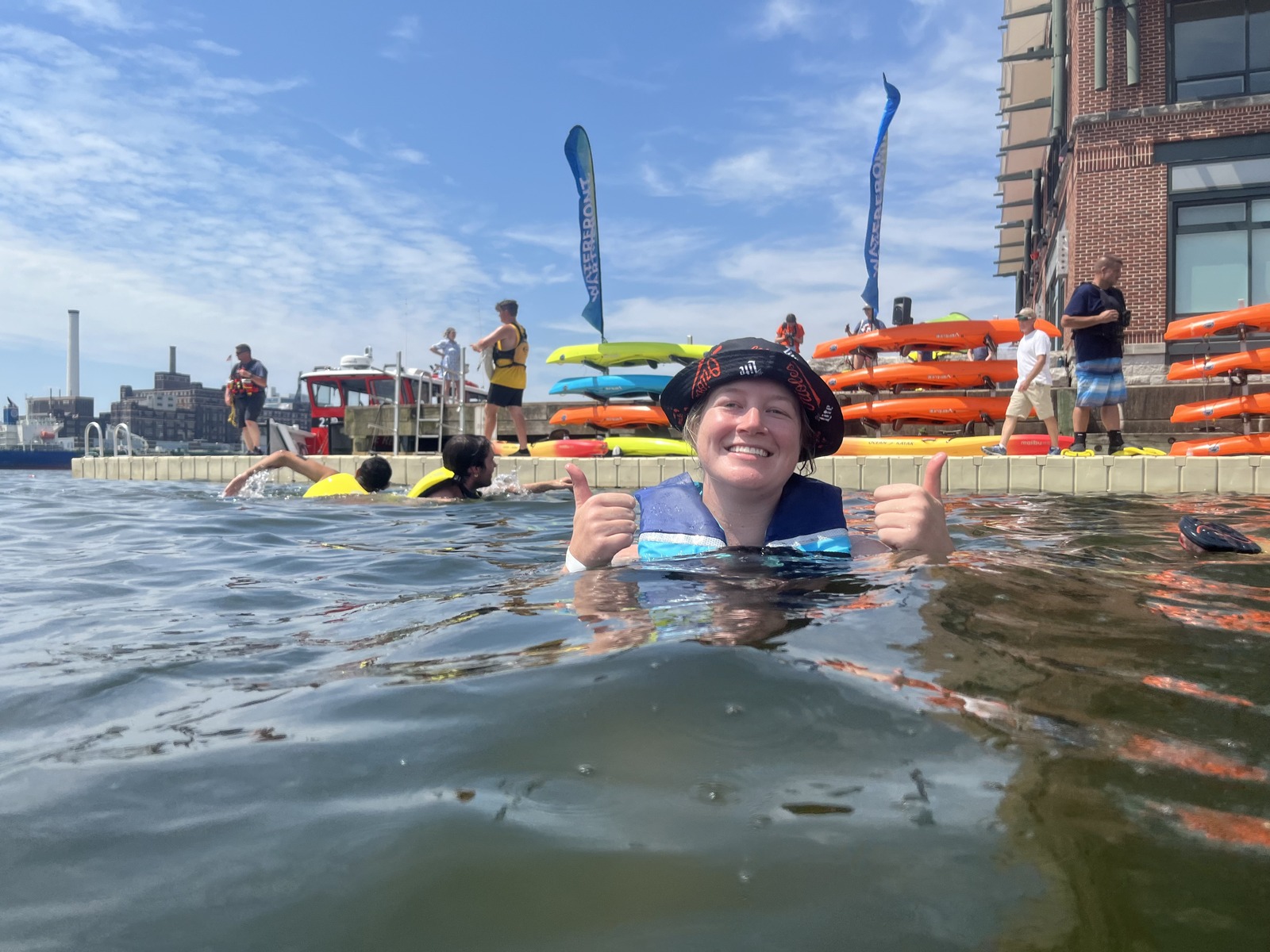
The celebration continued in October, when we had the honor of joining WPB to celebrate this year’s exciting milestones with the release of the 2024 Healthy Harbor Report Card. We reflected on the success of the Harbor Splash and Bay to Baltimore swim, hear plans for future events, and received a breakdown of the report card grading from Waterfront Partnership’s Laurie Schwartz and Adam Lindquist, Michael Hankin with Brown Advisory, Khalil Zaied with the Baltimore City Department of Public Works, Dr. Fernando Miralles-Wilhelm from University of Maryland Center for Environmental Science’, and artist and ultra marathon swimmer Katie Pumphrey.
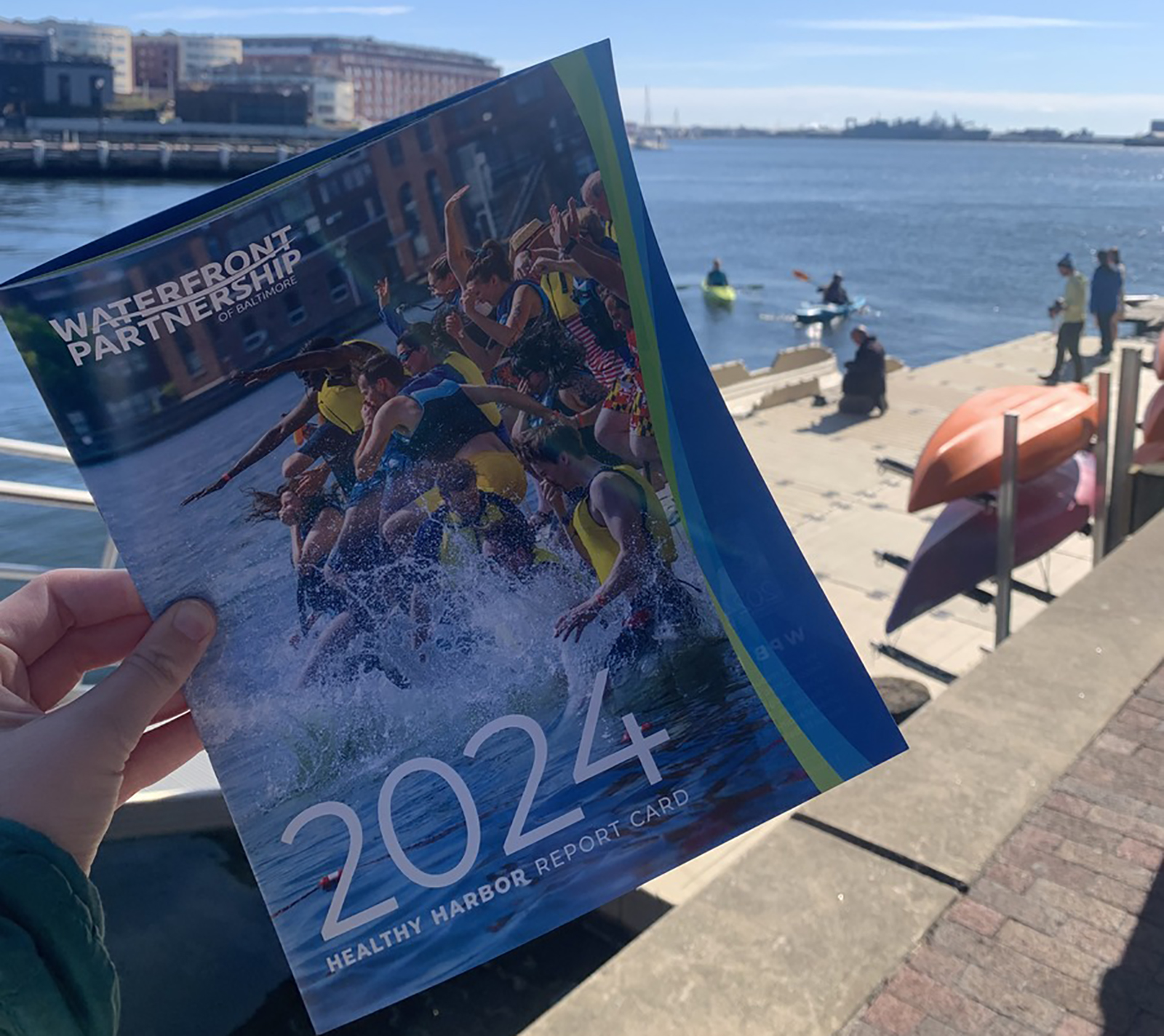
After the report card release, project partners cut the ribbon on a new publicly accessible Kayak Launch in Fells Point: the first project implemented as part of the Baltimore Blueway Master Plan! There are many notable landmarks and sights along the Blueway, including Fort McHenry, Mr. Trash Wheel, historical ships, multiple waterfront parks, and the new National Aquarium Harbor Wetland exhibit from Ayers Saint Gross. Among the many wins for Baltimore in 2024, it’s encouraging to see the National Aquarium add more floating wetlands to the Inner Harbor – and the ecosystem services, habitat, and wonder that come with them! We love it when a compelling concept is scaled up, and it was an honor to have helped develop the initial floating wetland prototype that was monitored by Aquarium staff before expansion moved forward.
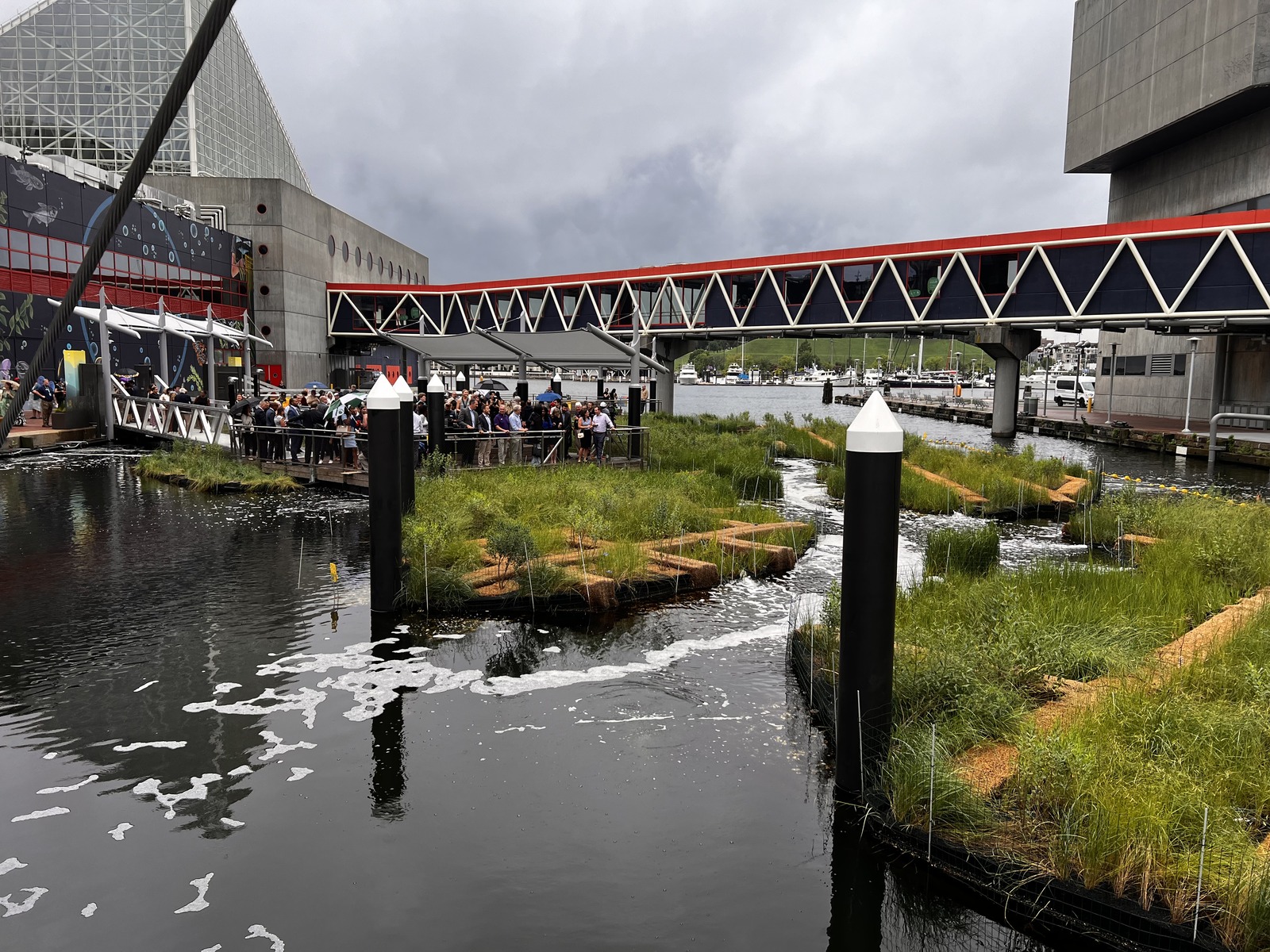
More improvements on the horizon, including a new kayak launch in the Inner Harbor and proposed access points and rest stops along the Baltimore Blueway. We love being part of a community that is committed to making Baltimore Harbor healthy and accessible. For more information about our work in Baltimore Harbor, feel free to reach out to Rebecca Winer-Skonovd.
Not Your Average Playground
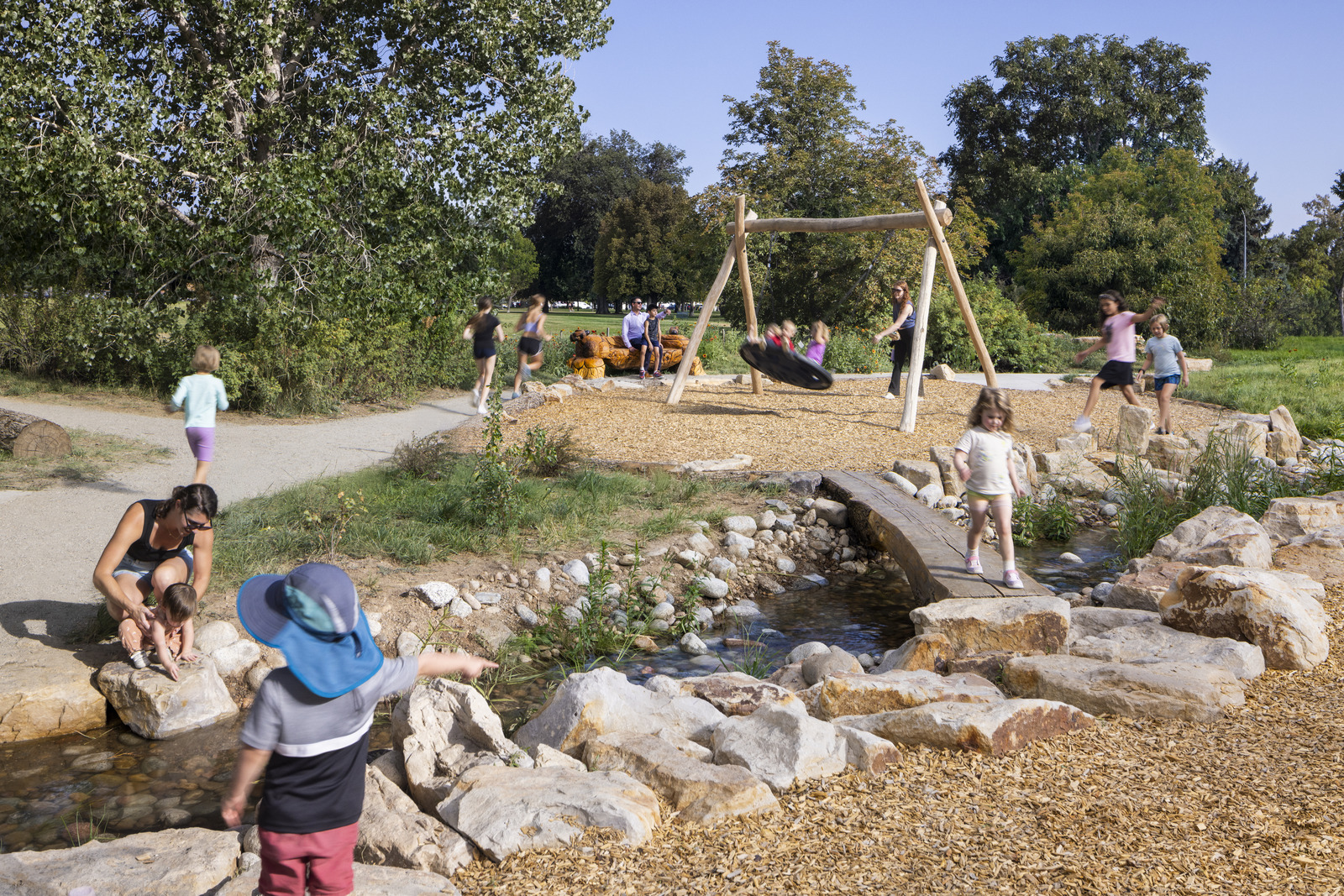
In our last issue of Leaf Litter, we highlighted the construction of Nature Play in City Park, a new ecology-focused, immersive play experience at the Denver Museum of Nature and Science (DMNS). After years of work from the Dig Studio project team, kids can now climb, slide, and scramble their way through eight of Colorado’s ecosystems along a restored waterway! We loved working on this project for DMNS and Denver Parks and Recreation as part of the Dig Studio team with Bienenstock Natural Playgrounds.
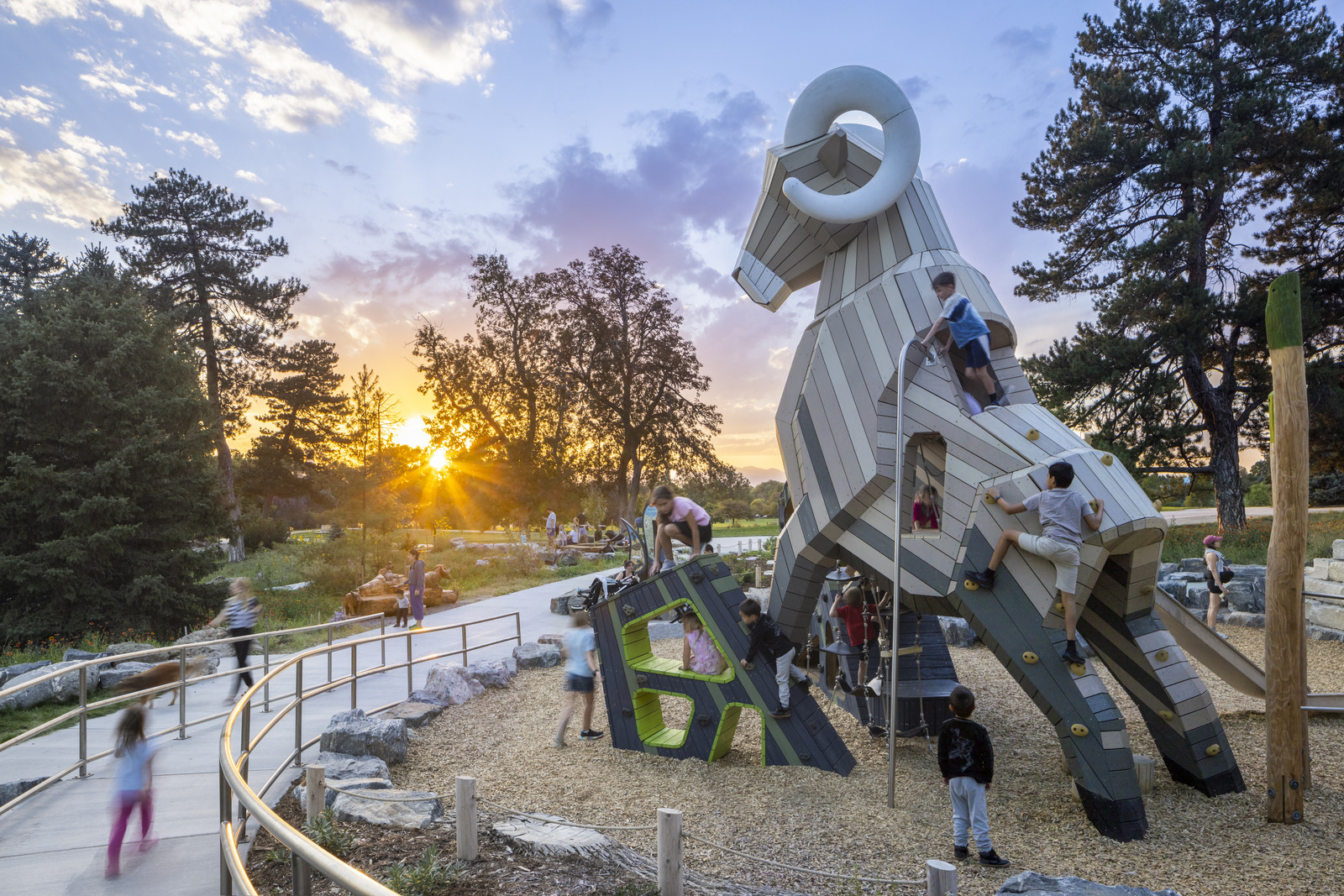
Colorado’s high alpine tundra, with its outcrops, boulder fields, and low-growing vegetation, is home to pika, marmots, ptarmigan, and other creatures that can survive long winters and high winds. It’s also where the journey through Colorado’s rivers begins. In this zone of DMNS’ Nature Play experience, you can climb up boulders, burrow into a pika den, and climb a bighorn sheep at the summit!

Steep and rocky, Colorado’s subalpine forest is home to chipmunks, martens, and other small mammals. Patches of spruce and fir trees intersperse with more expansive meadows. In the subalpine forest of the Nature Play experience, you can climb twisted trees, scramble up boulder steps, slide down a sloped rockface, and nestle yourself into the wings of a butterfly.
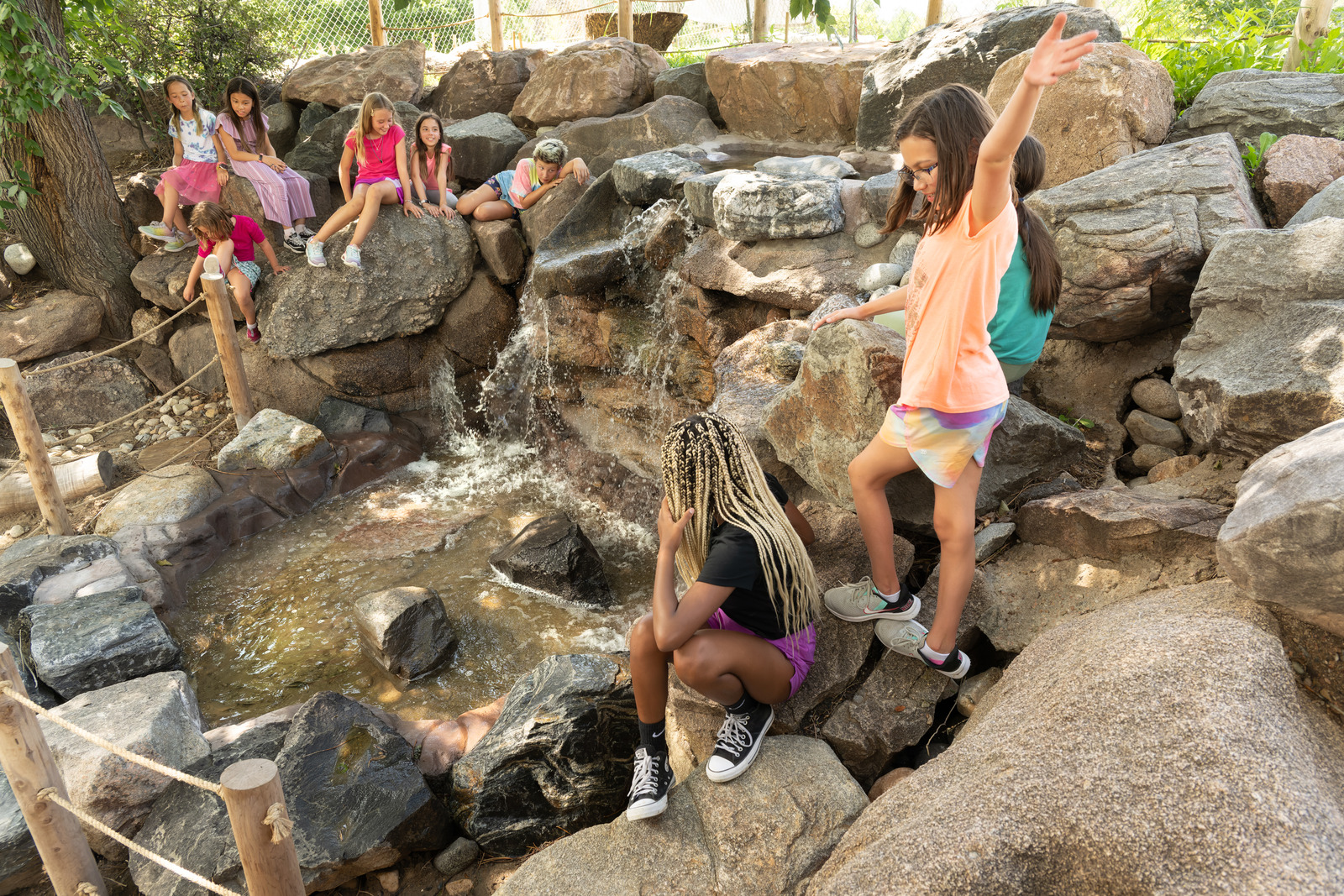
In Colorado’s montane forest, spruce and fir trees shade steep and rocky streams. Mountain chickadees, bluebirds, and jays chirp a cheerful backdrop to the vanilla scent of Ponderosa pine. In this section, you can climb up boulders, explore a box canyon and waterfall, or relax in a log chair and immerse yourself in the forest.
Water travels through steep boulder cascades, and native shrubs such as serviceberry, gambel oak, and mountain mahogany thrive in the rocky terrain of Colorado’s montane shrubland, providing food and cover for deer, elk, and black bear, and smaller animals including birds and butterflies. Search for their tracks in this area – or maybe you’d rather run through a maze of native shrubs or try your hand at building a bird nest out of sticks.

Found along the edges of rivers, streams, marshes and lakes, the riparian zone is one of Colorado’s most important ecosystems. This habitat, where land and water comingle, is rich in nutrients and biodiversity, supporting insects, birds, and mammals specific to this community. Kids that explore this zone can climb through a giant beaver lodge, traverse the restored waterway atop a fallen cottonwood log, and more!
Farther away from large creeks fed by snowmelt is one of Colorado’s lowest-elevation evergreen forests. In this area, you can play hide and seek in a maze of red sandstone. Immerse yourself in scents of sage and juniper while you follow the tracks of elk, coyote, and other critters who gobble the nuts and berries of piñon pines.
Home to iconic species like pronghorn and prairie dogs, this ecosystem is dominated by blue grama, sagebrush and other native grasses and shrubs. Sage grouse, sage thrashers, and a diversity of pollinators find food and cover in this vegetation. In this section, swing high above a sand wash, climb a wacky post net, and learn about sediment deposits as you dig for fossils at the waterway’s edge. Dominated by native grasses like buffalograss, blue grama, and purple three awn, this expansive ecosystem is home to prairie dogs, snakes, burrowing owls, jackrabbits, and a variety of other birds and mammals. Here you can roll around in a bison wallow, listen to a meadowlark, and run through tall grasses.
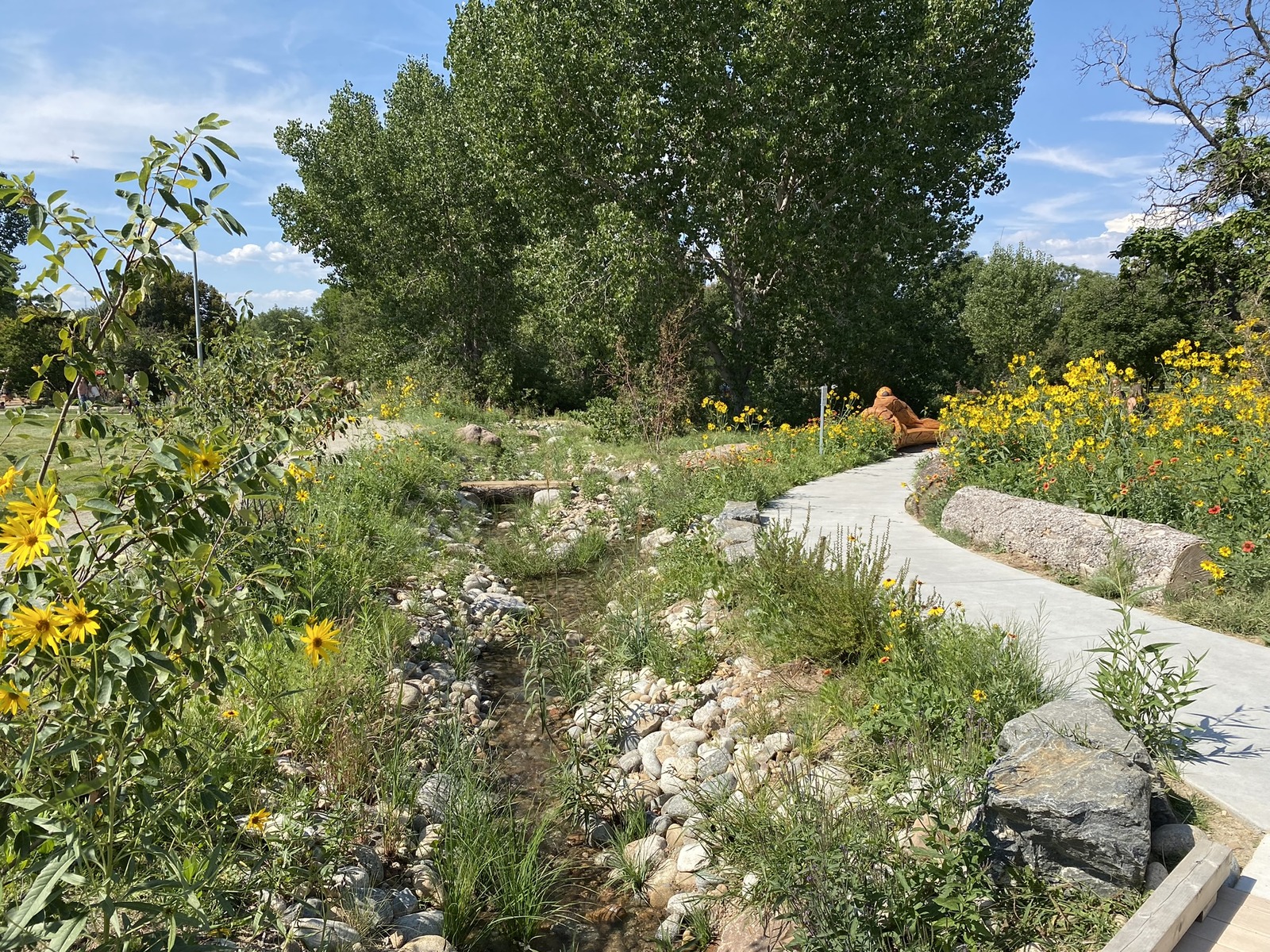
Working collaboratively with a team led by Dig Studio and integrating years of community input, Biohabitats provided analysis, ecological design concepts, restoration planning, and green infrastructure design support for Nature Play in City Park. We’re so excited that museum visitors are finally exploring this innovative play space! Please contact Claudia Browne for more information about Biohabitats’ role.
Great Teams Make Great Places
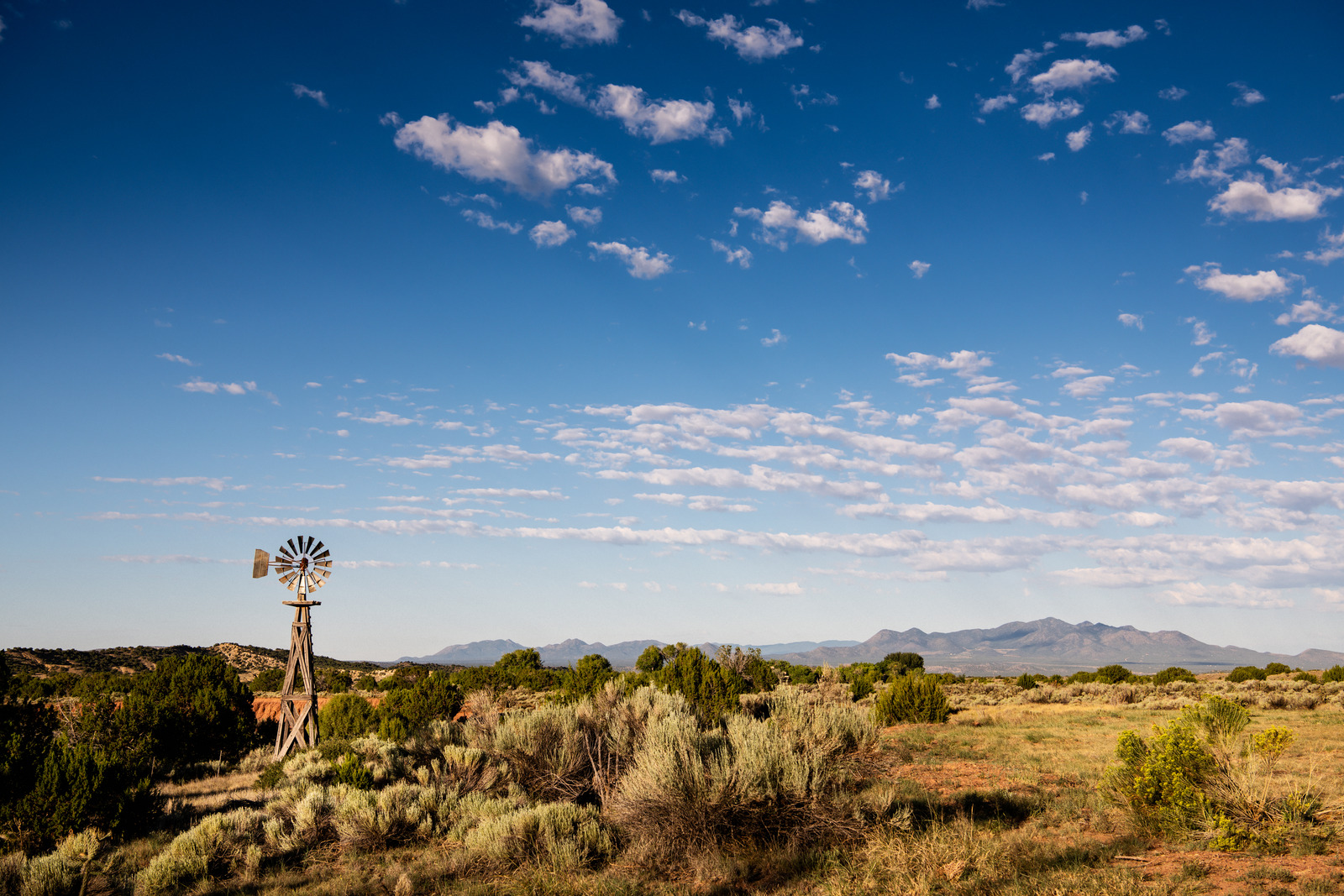
“Personal growth is especially enticing when the habitat is the dramatic, rich landscape of New Mexico.” -AnneLise Sorensen, Time Magazine, July 25, 2024
After its grand opening in spring 2024, the Modern Elder Academy’s new Santa Fe location was named one of Time Magazine’s 100 World’s Greatest Places for 2024!
Modern Elder Academy (MEA) aims to cultivate purpose and connection by building vibrant communities centered around a campus for midlife wisdom retreats and sabbaticals. Alongside collaborators AOS Architects, Surroundings Studio, JH Water Solutions, Santa Fe Engineering, and Sarcon Construction, Biohabitats helped the Modern Elder Academy develop innovative, sustainable water infrastructure that aligns with the academy’s principles, the site’s arid climate, and its proximity to Galisteo Basin Preserve, a large conservation-based community development with thousands of acres of protected grasslands and arroyos. For more information about this project, please contact Olin Christy.

A Greenway Grows in Lexington
“One of my favorite things about the planning process is being able to see the public come together to collaborate. As someone coming into Lexington from the outside, it was interesting to see people identify points on the ecological sensitivity map that we shared and see them make connections with the places they care about. It was a great experience to be around so many people who called Lexington home.” – Alyssa Burton, Biohabitats intern
The community of Lexington, Kentucky got together this fall to help The City of Lexington, Lord Aeck Sargent and Biohabitats develop a plan to connect Lexington’s network of parks, trails, and open spaces at the Greenway & Trail System Public Forum. Participants provided input on how to best protect and enhance the city’s wildlife corridors and neighborhoods while ensuring that all can enjoy Lexington’s natural areas through the Lexington Greenways Plan. This past spring Biohabitats led a geospatial ecological sensitivity analysis, examining existing canopy coverage, streams and riparian buffers, sensitive ecological features, parks, trail systems, and greenway areas across Lafayette County. Biohabitats created a map highlighting the degrees of ecological sensitivity to help shape the development of a natural areas greenway network.
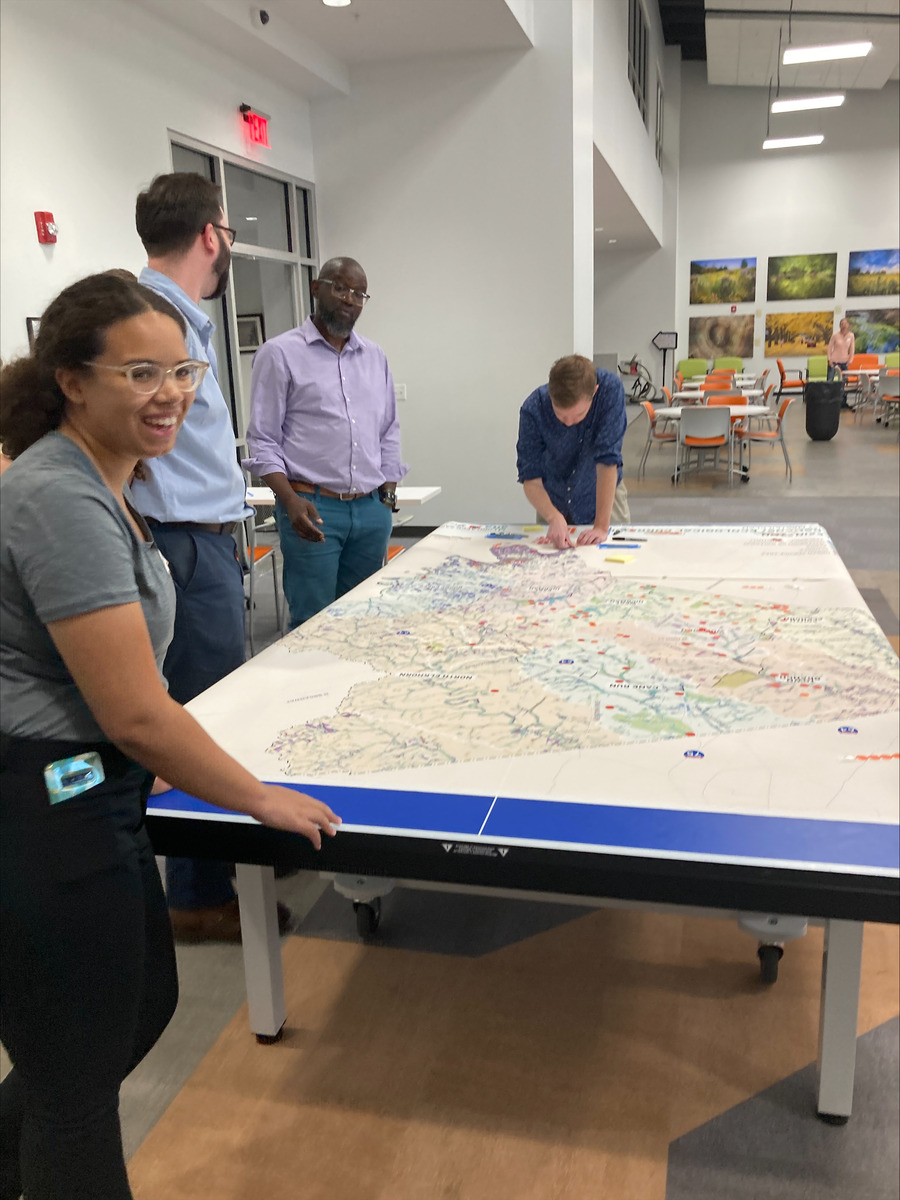
Through stakeholder and public input, the project team developed action items for priority pilot projects that aim to enhance and preserve the unique ecology of Lexington-Fayette County, protect important wildlife corridors, and integrate a cohesive network of parks, trails, and open spaces that support the city and surrounding community. The plan also provides guidance for residents, including homeowners and neighborhood associations, on best management practices to promote responsible stewardship. Engaging the community is a cornerstone of any successful project and ensures its impact is sustainable, equitable, and rooted in the collective values and needs of the people it serves. We can’t wait to see the City of Lexington meet its goals! For more information about Biohabitats’ role on the Lexington Greenways Plan, please contact Jennifer Dowdell.
Small Marsh in the Big Apple
Roll off containers are often associated with trash and waste…but not these! In partnership with the Trust for Governors Island as part of the Water Abundance Challenge grant program, Biohabitats and Just EcoCities are piloting a Tidal Planter. This wetland-in-a-box uses the natural cleaning power of a salt marsh to remove pollutants from New York Harbor and has the potential to bring this ecosystem to walkways and promenades throughout the city.

Biohabitats designed the Tidal Planter system, which included determining the most effective pump rate and correct tide cycles and choosing the best materials for the planter. This summer, Biohabitats’ Senior Water Resources Engineer/Hudson River Bioregion Team Leader Kevin Dahms, Water Resources Engineer Ellie Month, and Just EcoCities’ Jamie Ong had a great time demonstrating our modular wetland system to curious New Yorkers.
We had the opportunity to introduce a model of the Tidal Planter at the Trust for Governors Island Climate Piloting Summer Kickoff. Attendees used the model to explore the Tidal Planter’s function and trace the path that water will take through the Tidal Planter before being returned to New York Harbor. The in-progress full-size version was exhibited later on at the Climate Tech Showcase alongside the other innovative climate solutions being tested on the Island.
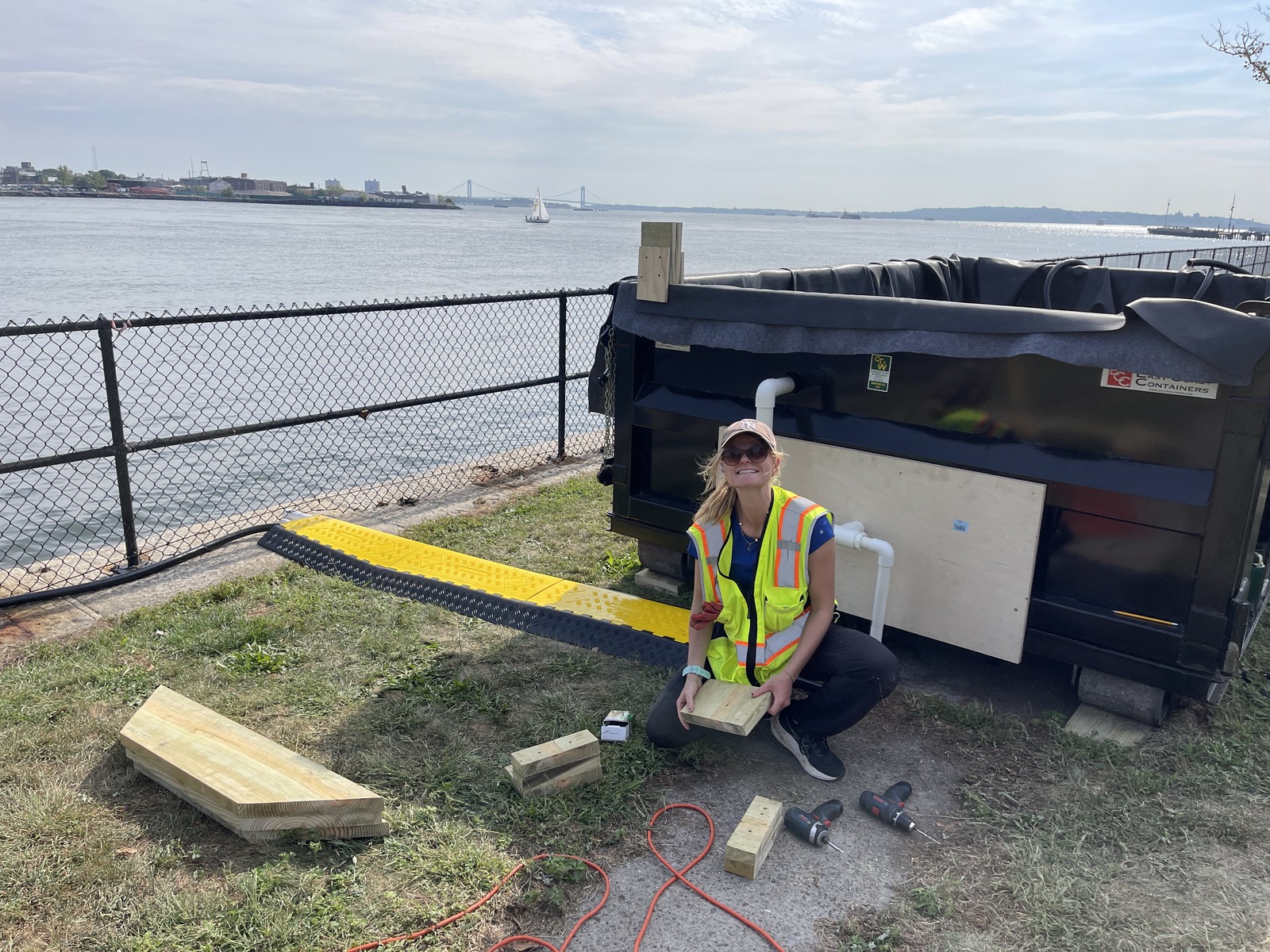
After the project team completed the construction and installation of the pilot in a large, repurposed roll-off container, students from Governors Island Harbor School were given a closer look during the installation of soil media and marsh plants.

We’re grateful that we’ve had so many opportunities to share this new climate technology and look forward to a future where functional, modular salt marshes provide a positive ecological impact along the shorelines and sidewalks of New York City! For more information about this work, contact Kevin Dahms.
Award-Winning Work
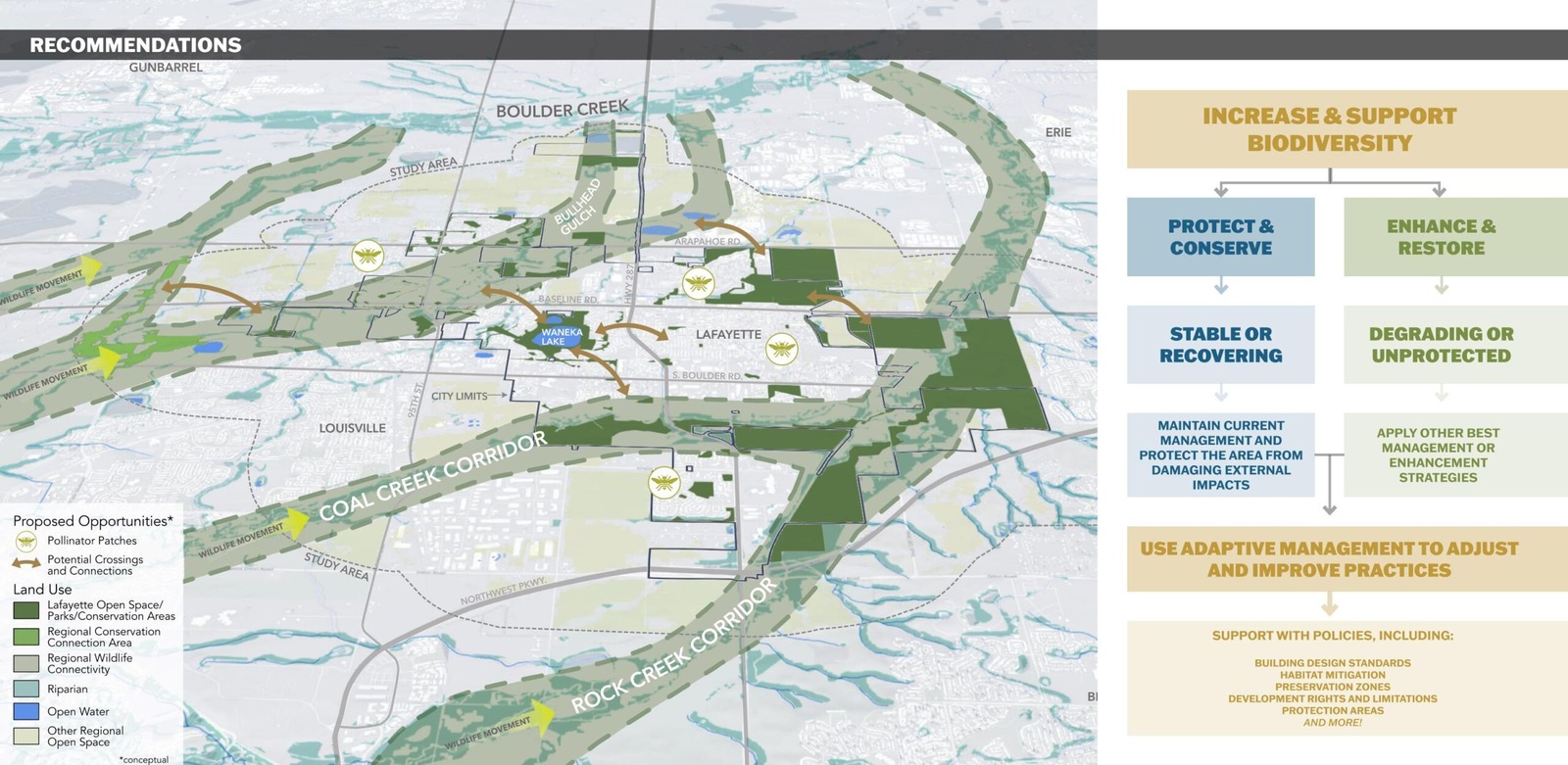
Earlier this year, the Lafayette Wildlife Plan received a Merit Award in Analysis and Planning from ASLA Colorado! Biohabitats helped develop the plan for the City of Lafayette Colorado with Dig Studio and Wildlife Specialties LLC., and we’re so excited to see this work being recognized. Congratulations to the project team! For more information about this project, please contact Claudia Browne.

The Buffalo Bayou Park Revegetation and Biostabilization project received a 2024 Water Innovation Strategies of Excellence (WISE) Award in the Research and Monitoring category from the Houston-Galveston Area Council! This project used native vegetation to stabilize a 2.5-mile reach of Houston’s Buffalo Bayou, and we’re honored to have provided revegetation recommendations as part of the SWA Group team. Congratulations to the Harris County Flood Control District, Buffalo Bayou Partnership, SWA Group, and Resource Environmental Solutions on the recognition! For questions about this project, please contact Susan Sherrod.
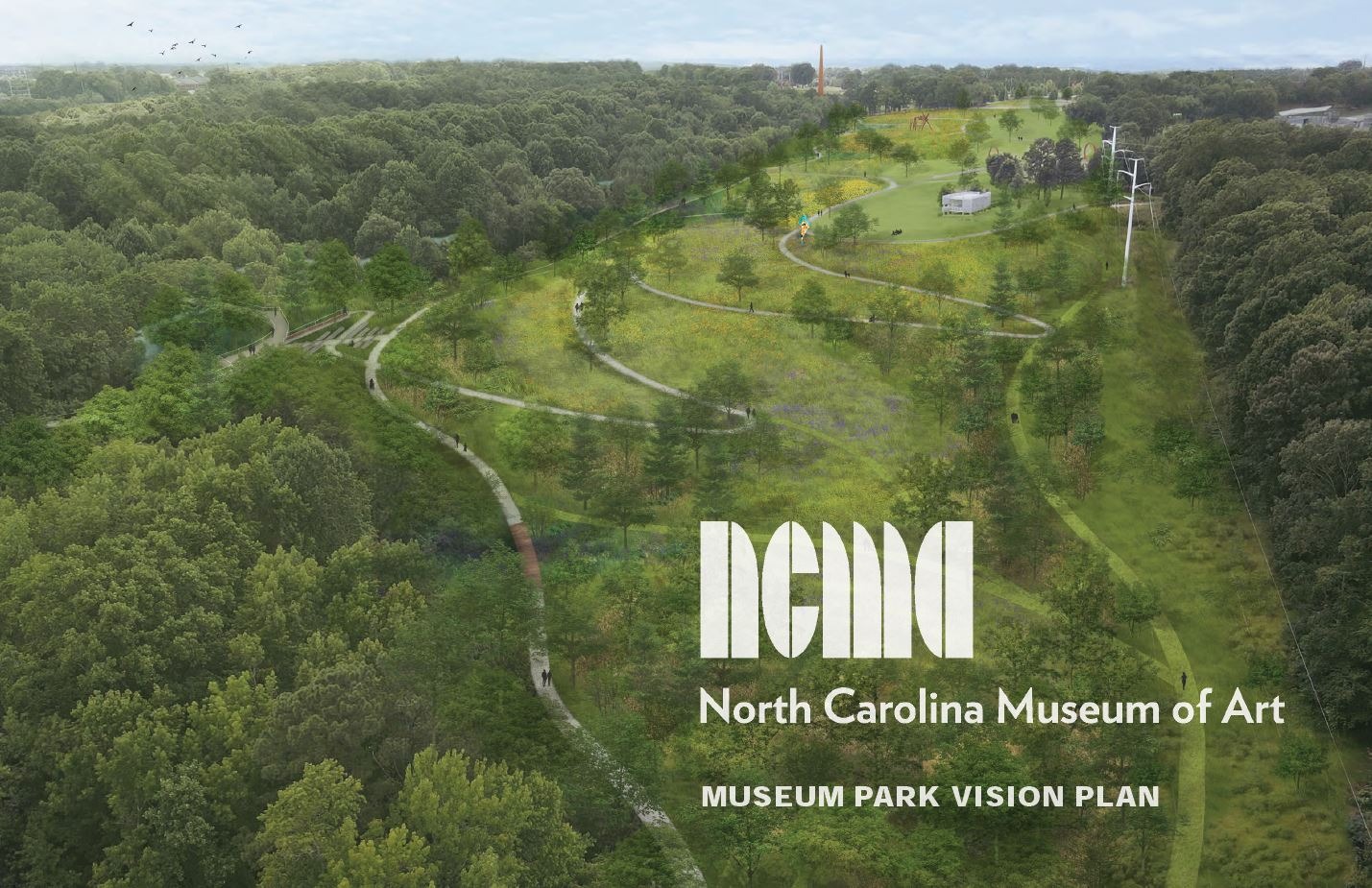
The North Carolina Museum of Art’s Ann and Jim Goodnight Museum Park brings people, art, and nature together on a 164-acre campus of trails and outdoor sculpture. Biohabitats is honored to have helped the museum strengthen these connections as part of the award-winning Museum Park Vision Plan team led by Andropogon Associates, and we’re excited to share that this project received a 2024 Merit Award in the Analysis & Planning category from ASLA North Carolina! For more information about this project, please contact Kevin Nunnery.
There was so much to celebrate at the 2024 AIA Conference on Architecture, including the announcement of this year’s COTE® Top Ten award winners, and we’re proud to share in multiple wins with our project partners! Congratulations to Edlen & Co, ZGF Architects, PAE Engineers, KPFF Engineers, and Walsh Construction Co. on the award for the newly certified PAE Living Building. Biohabitats helped design the buildings innovative onsite water infrastructure.

Last but certainly not least, congratulations to Lake Flato and their amazing team on the recognition for the LEED Platinum-certified USG Biomedical Sciences & Engineering Education Building! Biohabitats was honored to help integrate water management and ecology into the design of this sustainable building on the University of Maryland campus.
Places
A Wetland Weekend in New Jersey
Earlier this year, we joined the Teaneck Creek Conservancy, the Bergen County Department of Parks and Recreation, and a great community of stewards for a Wetland Weekend celebration. Saturday’s event was a fun, family-friendly Restoration Ramble through the restored wetlands at Teaneck Creek Park. Sunday was an opportunity to toast the many people who care for and support the Park at a champagne brunch.
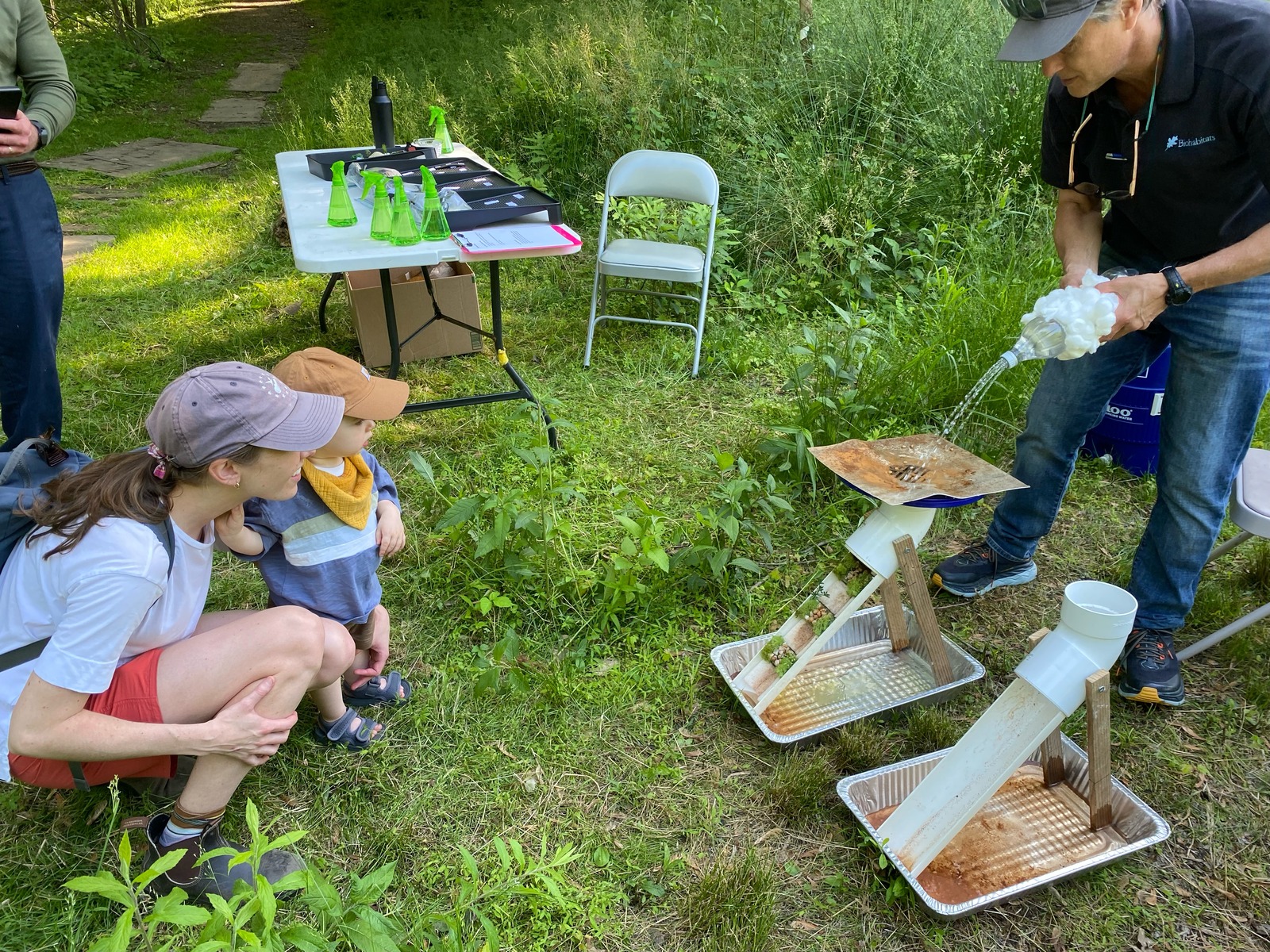
At both events, Biohabitats President Ted Brown used a simple model to demonstrate how water moves on the landscape, and how regenerative stormwater conveyance (RSC) techniques/structures are helping to restore ecology and water quality in Teaneck Creek Park. Visit the site to check out a beautiful wetland restoration for yourself, and all the flora and fauna that come with it! For more information about this project, please contact Kevin Dahms.
Next Generation Water Summit
“Making a reasonable effort at net zero will enhance important water resources in a changing climate, even if a user doesn’t reach the ambitious goal.” -Shayla Woodhouse
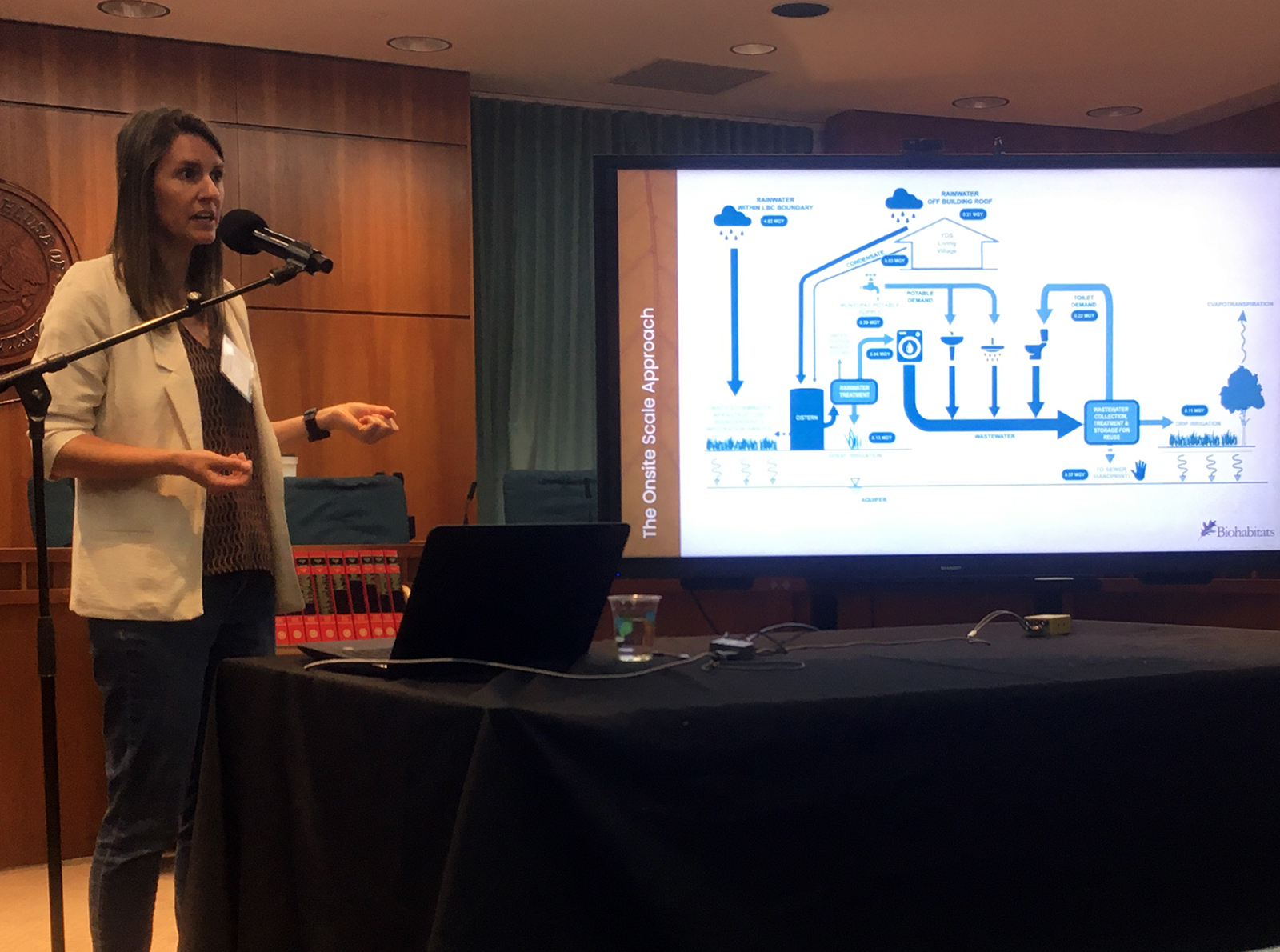
Biohabitats’ Project Engineer Shayla Woodhouse is passionate about net zero water strategies, and she recently shared her expertise on net zero water use in commercial buildings with professionals and policymakers at the Next Generation Water Summit. Hosted in Santa Fe, the summit is a collaborative environment to share best practices and innovative water conservation and reuse techniques that can be used to meet conservation restrictions in the southwest. Learn more in the Santa Fe New Mexican! (Article correction: The cistern volume at the PAE Living Building is 71,000 gal).
Canoe & Scoop!
We had a blast in September canoeing and scooping up trash to help clean up the Middle Branch of the Patapsco River!
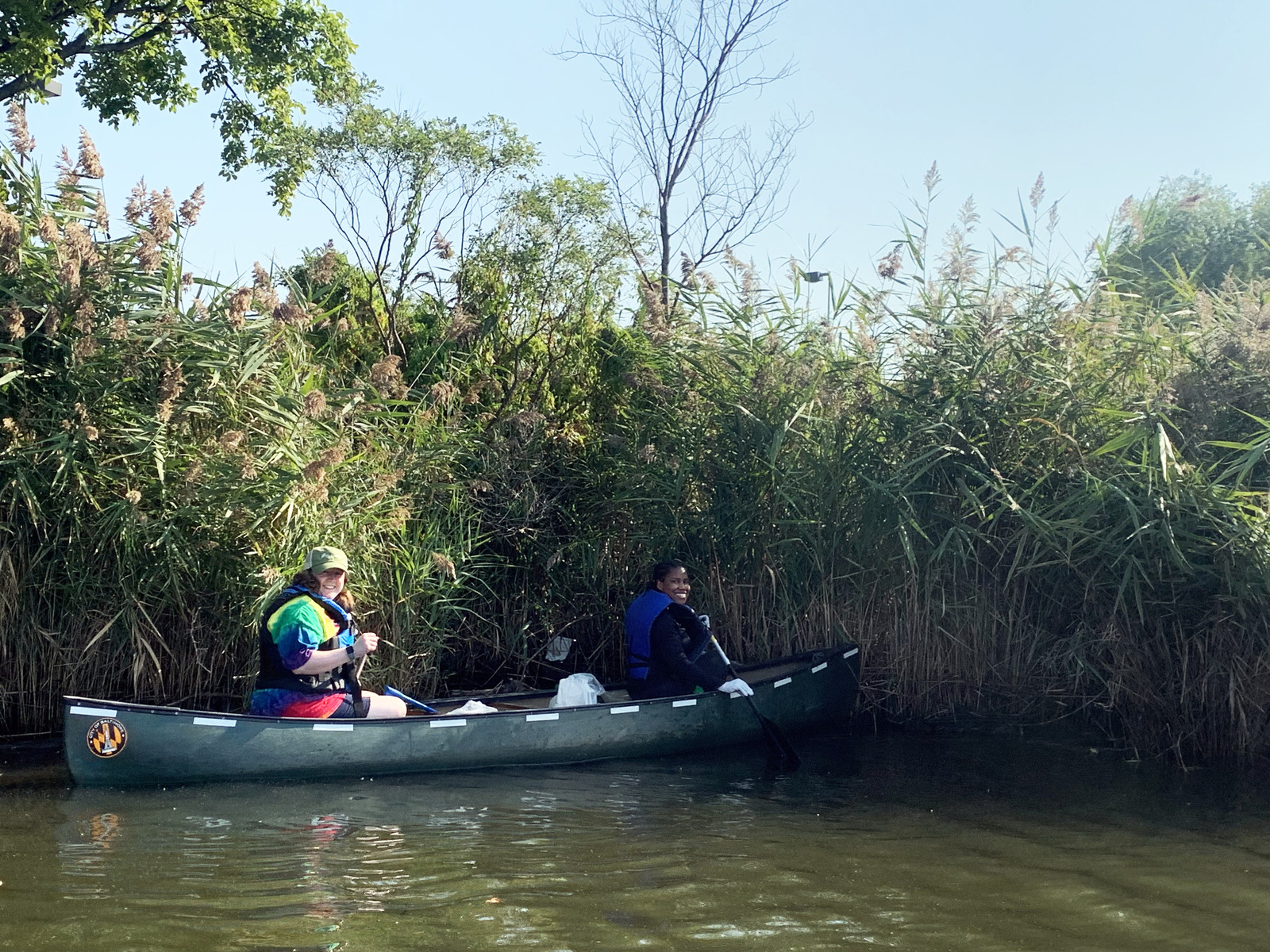
It was a beautiful day to be on the water, and a wonderful way to volunteer with our community and Baltimore City Parks and Recreation. Learn more about Canoe and Scoop opportunities in Middle Branch Park and other outdoor programs on the Baltimore City Rec and Parks website.
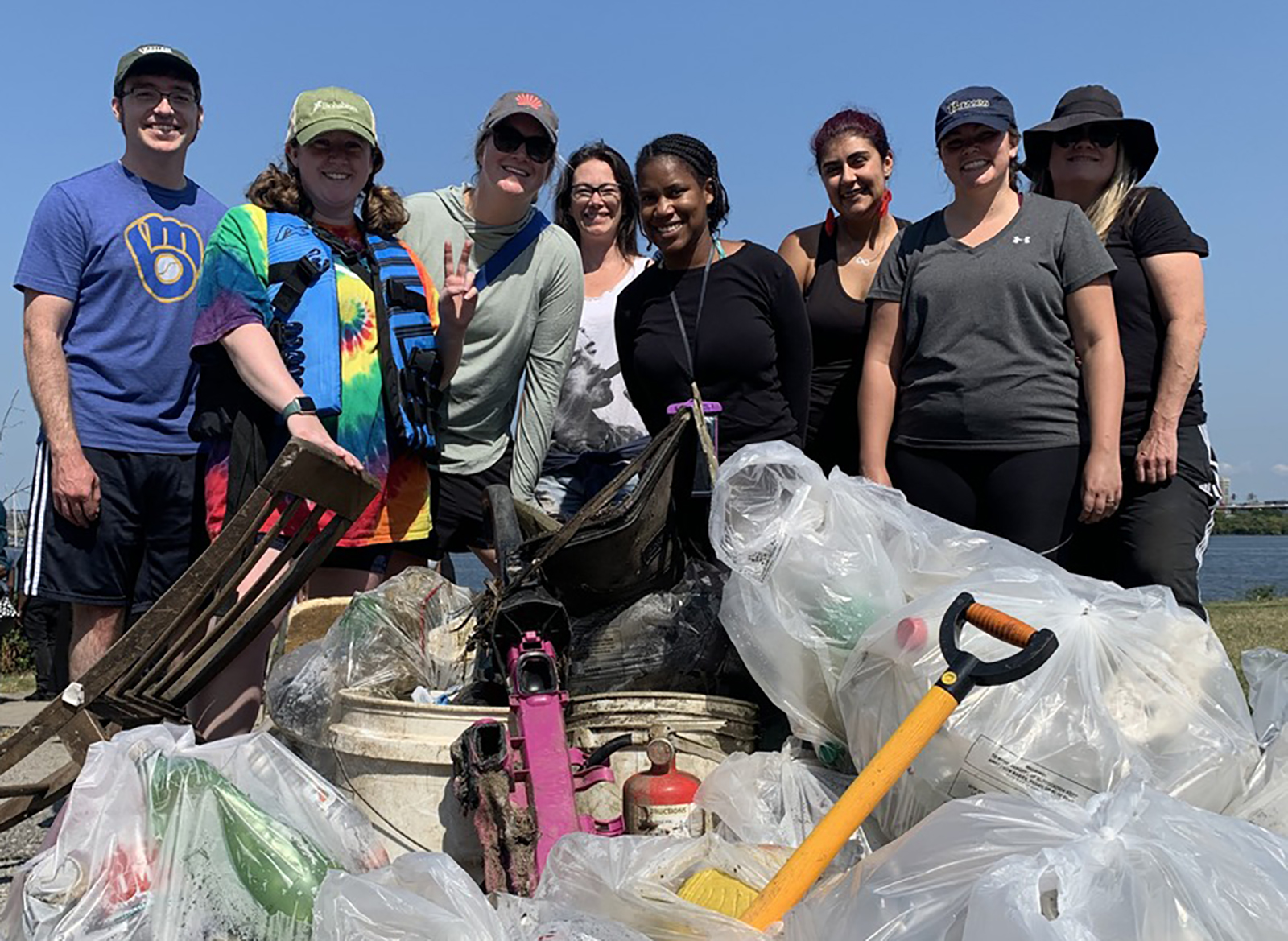
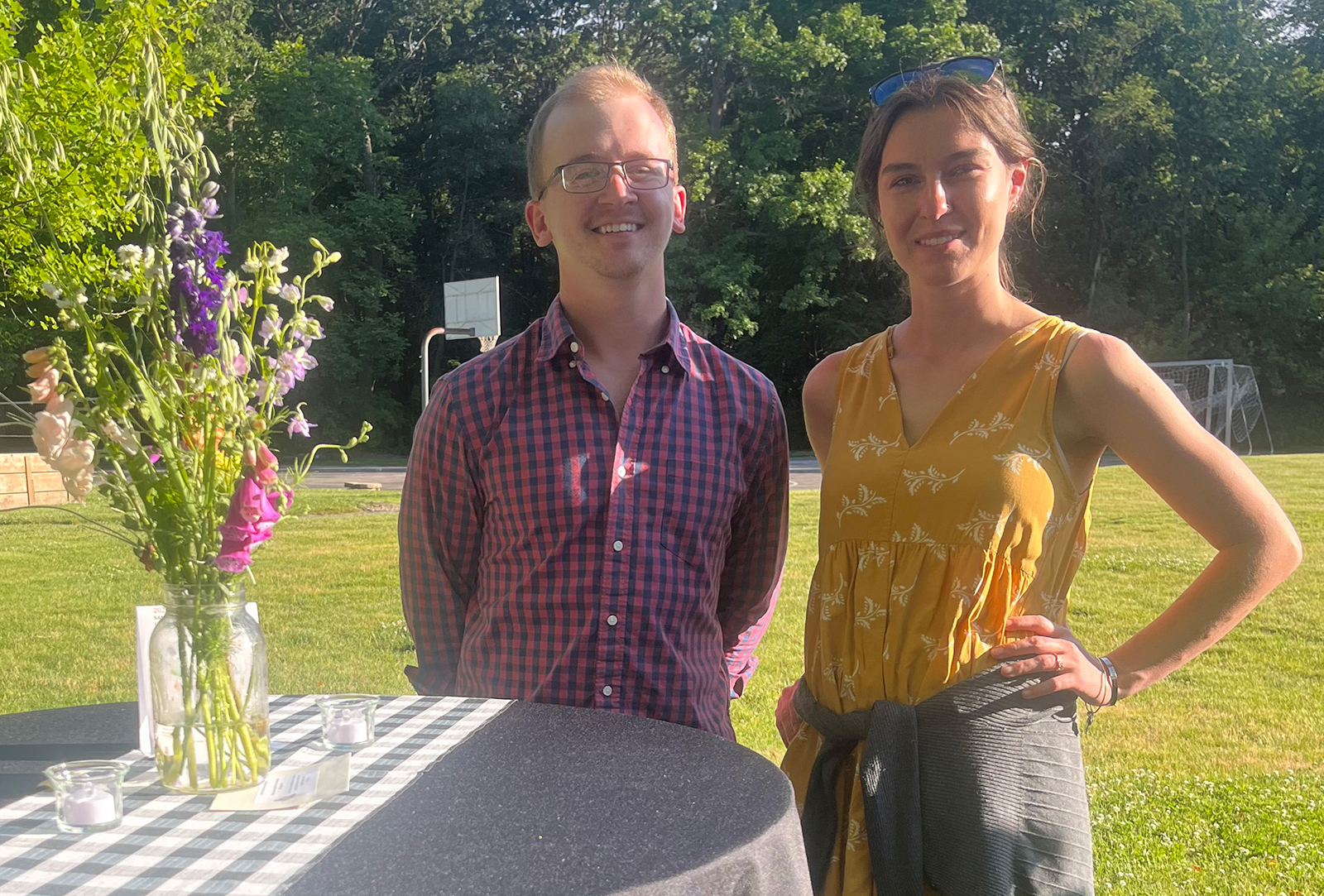
So Wild a Place
It was a wonderful evening with friends, colleagues, and fellow conservation fans at this year’s So Wild a Place fundraiser! We always look forward to this event, and we so appreciate the opportunity to support the Black Swamp Conservancy’s amazing work preserving natural habitats and family farms in northwest Ohio
Up A Creek
Our friends at West Creek Conservancy work hard to protect & restore ecosystems in Northeast Ohio and expand opportunities to connect with nature. It was an honor to support their work while having a great time at their annual Up! A Creek fundraiser!

A Swinging Time
It was an honor to support and play in the annual Jim Gracie Memorial Scholarship Golf Tournament hosted by the Maryland Stream Restoration Association. The scholarship supports students pursuing careers in natural resources, with preference given to disadvantaged applicants.
People
New Mexico Must Become a Catcher of Rain
“In an age of megadroughts, dangerous decimation of groundwater and wildfires in our watersheds, we need to improve our ability to harness and decentralize water. We should invest in the capacity to collect and store far more of what falls from the sky.”
New on the Rhizome blog: the Center for Economic and Policy Research‘s Justin Zorn and Biohabitats’ Senior Engineer/Practice Leader Erin English propose how companies and local governments can scale up rainwater harvesting to address the ongoing water crisis. Read the full article on our website.
Webinars with Biohabitats
“What is true place-based design? For us, it means really following nature’s lead and following the ecological processes and relationships that hopefully move us back toward more of an authentic landscape and a sustainable alternative.” – Biohabitats founder, Keith Bowers
Biohabitats’ Founder Keith Bowers joined East Bay Regional Park District‘s Dr. Ana M Alvarez, The Nature of Cities’ David Maddox, and moderator Kristina Hill with Berkley’s College of Environmental Design to discuss what the larger biodiversity movement means for landscape architects and other big questions in the Biodiversity Trends for Landscape Architects webinar from the Landscape Architecture Foundation.
Restoring ecosystems within our communities offers valuable lessons in how vibrant and adaptive landscapes strengthen our civic fabric. Explore a variety of ecological restoration examples that highlight how biodiversity is reintroduced in the public realm, discuss strategies for engaging in strategic partnerships that support long-term research efforts as part of the design process, and more with Biohabitats’ Jennifer Dowdell, Phyto Studio‘s Claudia West, and Andropogon Associate’s Martha Eberle at their ASLA 2024 session “Restoring to What? Addressing Biodiversity in the Era of Climate Change.” Register for the full series of Biodiversity & Climate Action 101 webinars to access
Rewilding Earth Podcasts
On episode 132 of the Rewilding Earth podcast, Biohabitats ‘ Senior Ecologist Dr. Jessica Hardesty Norris joins host Jack Humphrey for an in-depth discussion on the role of restoration companies in conservation, future opportunities and challenges, collaboration, and the importance of small-scale restoration. Listen now!
On episode 135 of the Rewilding Earth podcast, Dr. Todd Bridges with the University of Georgia College of Engineering discusses the history of sustainable engineering, current projects, and his extensive career with the U.S. Army Corps of Engineers, where he initiated the ‘Engineering with Nature’ program. Listen here.
Meet Our Newest Team Members!
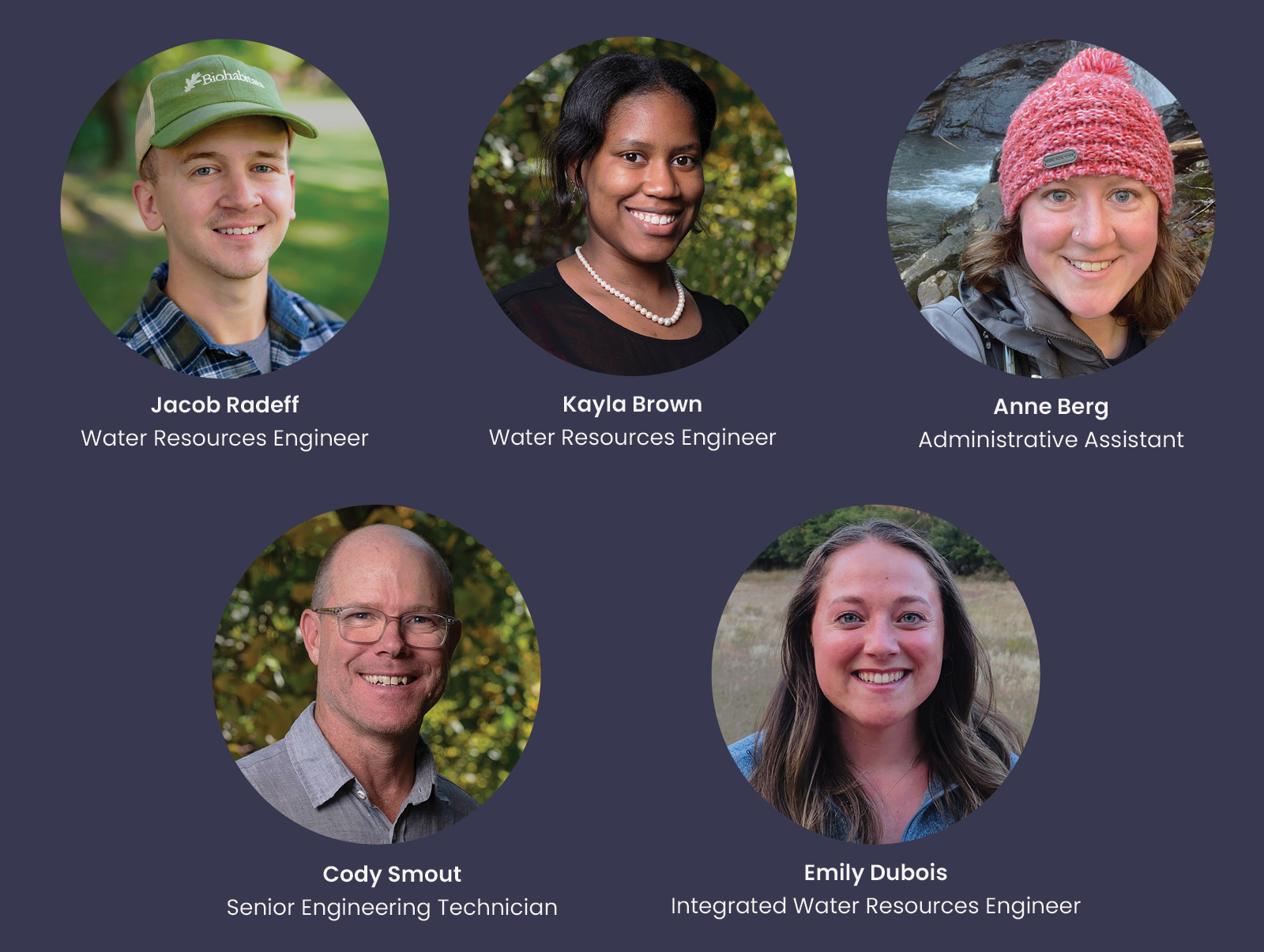
Join us in welcoming Water Resources Engineer Jake Radeff, Water Resources Engineer Kayla Brown, Administrative Assistant Annie Berg, Senior Engineering Technician Cody Smout, and Interdisciplinary Water Resources Engineer Emily Dubois to the Biohabitats team! Can you guess which new team member takes their dog Nordic skiing/skijoring? Who is a big fan of Psychedlic cumbia? How about the road tripper who has driven almost 20,000 miles to hit 22 National Parks in the last year? Who has the goal of traveling to as many countries as possible? Find out on the Rhizome blog!
Incredible Interns
What gives us hope? The next generation of passionate, dedicated restoration professionals! This summer, we were honored to host interns Alyssa Burton, a University of Louisville graduate with a Bachelor of Science in Urban Studies, with a focus on Urban Planning; Anoosh Tauqir, a senior at George Washington University majoring in Civil and Environmental Engineering and minoring in Sustainability; and Jaye Hoyte, a first year Master of Landscape Architecture student at the University of Pennsylvania who received his Bachelor of Urban Planning from Columbia University, and Master of Urban Planning from Georgetown University–with a concentration in sustainable urban infrastructure. Learn more about their experiences as Biohabitats interns on the Rhizome blog.
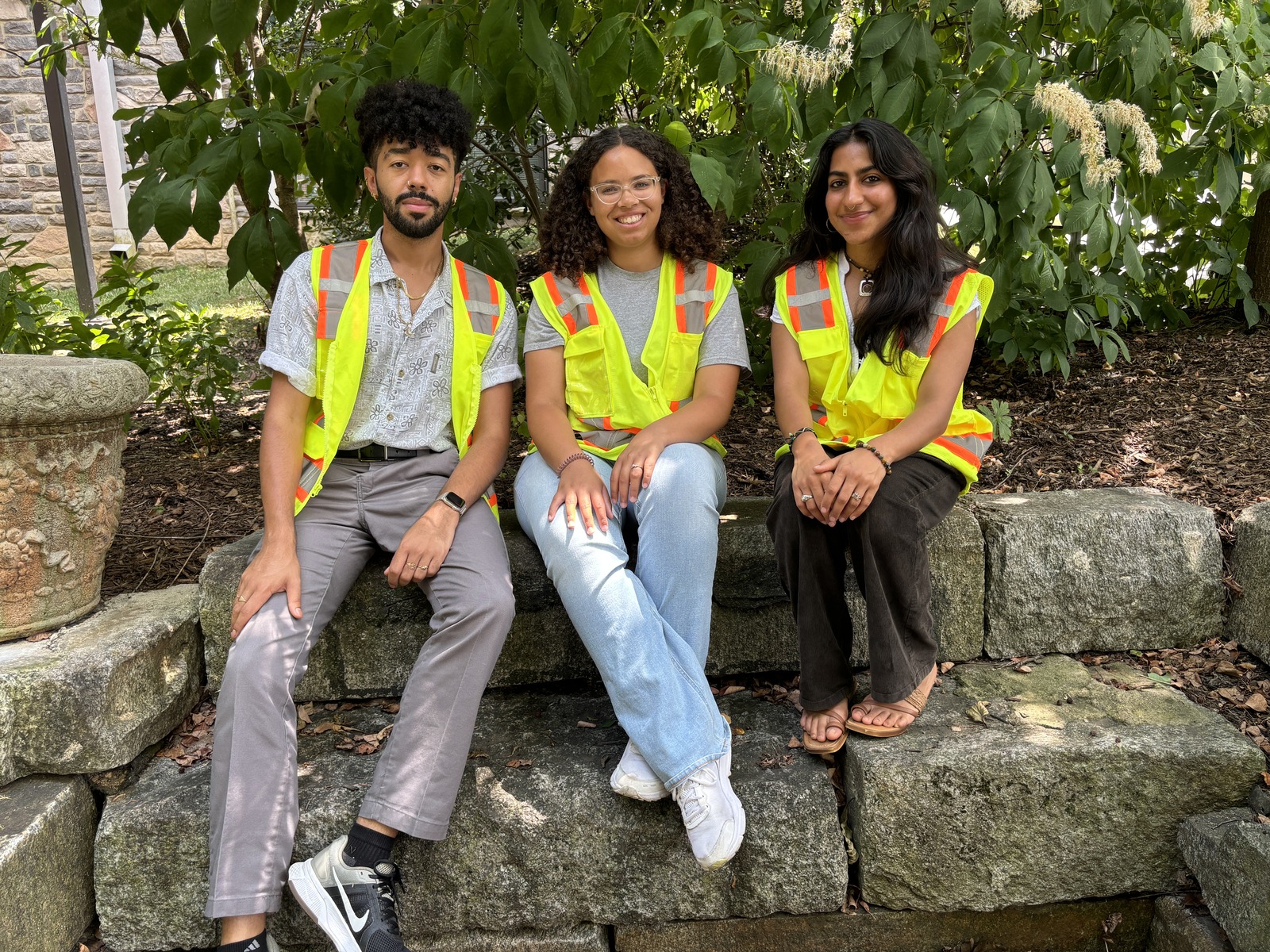
The application season is now open for Biohabitats’ 2025 Interdisciplinary Internship Program! Designed to provide people of color and women with the opportunity to explore career pathways within the environmental consulting world, this internship program prioritizes candidates from Historically Black Colleges and Universities, Hispanic Association of Colleges and Universities, and Tribal Colleges and Universities. Our interns gain practical, hands-on experience on real projects, expanding their skillsets and future career opportunities. Any applications received will now be considered for our 2025 spring/summer program. Learn more and apply on our website.
Golden Acorn Award
Biohabitats’ quarterly Golden Acorn award is presented to a team member who has excelled in demonstrating our mission to “Restore the Earth and Inspire Ecological Stewardship.” The gold color symbolizes purity of purpose in protecting and defending nature, and the acorn symbolizes strength of resolve. Golden Acorn winners are awarded $1000 to donate to non-profit organizations of their choice. Recent winners of the Golden Acorn award were Senior Ecologist Susan Sherrod from our Southern Rocky Mountain Bioregion, Senior Engineer/Practice Leader Erin English from our Southwest Basin & Range Bioregion, Senior Ecologist Josh Wilson from our Northeast Highlands & Coastal Bioregion, and Environmental Scientist Tanaira Cullens from our Chesapeake & Delaware Bays Bioregion Office!
Susan chose Flower Hill Institute as the recipient of her Golden Acorn donation, Erin directed her donation to the Northern Jaguar Project, Josh’s donation went to the organization Solar Youth, and Tanaira chose the Black Church Food Security Network and Backyard Basecamp as the recipients of her donation. Congratulations to our Golden Acorn winners!
